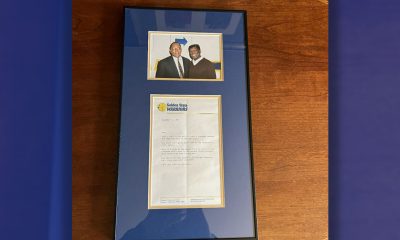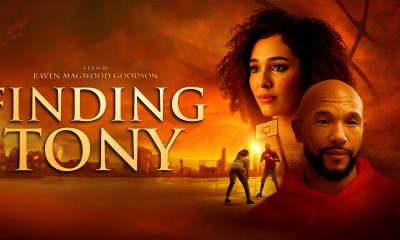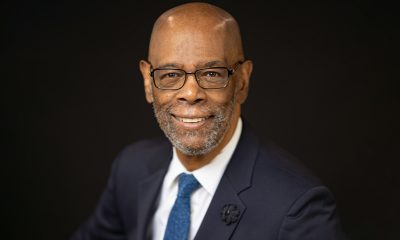Sports
DeAndre Jordan Happy with Clippers After Free Agent ‘Fiasco’

Los Angeles Clippers DeAndre Jordan, middle, the league rebounding champion, is reintroduced at a Staples Center news conference with teammates, forward Branden Dawson, left, and guard Austin Rivers, right, in Los Angeles on Tuesday, July 21, 2015. (AP Photo/Nick Ut)
GREG BEACHAM, AP Sports Writer
LOS ANGELES (AP) — DeAndre Jordan thought the Dallas Mavericks offered everything he wanted, including a fresh start and a starring role.
Then Jordan thought about it some more, and the craziest free-agent recruitment story in recent NBA history ended with him back on the Los Angeles Clippers.
“When free agency started, this whole fiasco was not my intent,” Jordan said Tuesday.
Jordan celebrated his 27th birthday at Staples Center with the Clippers, proudly holding up the revamped version of his familiar No. 6 jersey alongside new teammates Paul Pierce and Josh Smith.
Yet Jordan realizes he nearly derailed the Clippers’ title hopes and definitely disrupted Dallas’ retooling plans by backing out of his verbal commitment. The two-time NBA rebounding champion changed his mind after days of existential angst and a frantic trip to Houston by the Clippers’ leaders to sit out the final hours of the signing moratorium together.
Jordan knows he picked an awfully weird way to stick with the same team, but he regretted the decision to join the Mavs shortly after making it.
“Originally with Dallas, I thought I wanted change,” Jordan said. “I wanted a bigger role and more responsibility, and I was ready to embrace and accept that challenge. But (when) I got by myself and I was able to think about everything that just happened, I realized that being with the Clippers was the best decision for me.”
Jordan has spent his entire seven-year career with the Clippers, who have made four straight playoff appearances for the first time. After decades of incompetence, they’ve become one of the NBA’s elite teams with Jordan, Chris Paul and Blake Griffin leading the way under coach Doc Rivers.
Jordan decided he had to find out how this story ends.
“I really thought about being on one team for my entire career,” said Jordan, who agreed to a four-year, $87.6 million deal to return. “That was really important to me. I’ve been here, and the past few seasons I’ve had have been pretty successful. I also feel like personally, I know the city. I know the fans. I’m used to the city of L.A., and I love it here.”
With four straight winning seasons and a growing fan base, the Clippers have shaken off their lamentable history under Donald Sterling and opened a prosperous new era under billionaire owner Steve Ballmer.
The Clippers also retooled their roster after their second-round playoff exit this spring — even if it would have meant much less if the big man had left a hole in the middle. Instead, Jordan was all smiles at Staples Center alongside fellow returnee Austin Rivers and five new teammates: Pierce, Smith, Wesley Johnson, Cole Aldrich and rookie Branden Dawson.
“First of all, he never left,” Rivers said. “I keep hearing that he came back. He never left. He talked about it, but he came back. I tell DJ all the time, you should be celebrated for making the right decision. I think he had that right to do that. It has happened before. It happens in business all the time, and the difference is, what we do is public, so everybody gets a chance to talk about it.”
Jordan realizes he left plenty of angry fans back in his home state. Mavericks owner Mark Cuban has dismissed the apology posted on Jordan’s Twitter account.
“We make decisions in life, and when you go back and change your mind on them, I feel like the only thing you can do is man up and apologize for it,” Jordan said. “And that’s what I did. I can’t speak for Mark or anybody else.”
Jordan has led the league in rebounding and field-goal percentage for two straight years, yet his initial logic for leaving the Clippers suggests he occasionally feels overlooked in the shadow of his two All-Star teammates. Still, he scoffed at the idea he has a fractured relationship with Paul.
“I love Chris,” Jordan said. “When Chris got here, he changed the culture of our team. He helped me out in so many ways on and off the floor, just becoming a better player and a student of the game. I know it may look (like an argument) on the floor because we’re both emotional and vocal players. But when it comes down to it, we’re criticizing each other because we want what’s best for the team.”
Rivers and Jordan both laughed at the memory of July 8, which the Clippers’ leaders spent holed up in Jordan’s home before he could sign his deal. Griffin kept fans entertained by tweeting photos of a chair wedged under the knob on Jordan’s front door, or a tent in the backyard at the supposed siege.
“It wasn’t a hostage situation,” Jordan said with a grin. “I feel like I’m a pretty big guy, and I don’t think they could lock me inside my own house.”
“Oh no, we could lock him up,” Rivers interjected. “If we wanted to, that would have happened.”
Copyright 2015 The Associated Press. All rights reserved. This material may not be published, broadcast, rewritten or redistributed.
Business
Sacramento Kings and Black-Owned Digital License Plate Firm Enter History-Making Partnership
Reviver founder and Chief Strategy Officer Neville Boston attended the Sacramento Kings’ season opener at Golden 1 Center, witnessing players debut the company’s patch. Reviver proudly supports the Sacramento Kings’ community and diversity, equity, and inclusion initiatives. Photo by Antonio Ray Harvey, California Black Media (CBM).

By Antonio Ray Harvey, California Black Media
Reviver, the world’s first digital license plate and connected vehicle platform, has entered into a history-making jersey patch partnership with the Sacramento Kings, team officials announced right before the team’s season opener on Oct. 24.
The collaboration establishes Reviver as the first Black-founded technology jersey patch partner in the National Basketball Association (NBA).
The Reviver logo now appears on the left front strap of Kings’ uniforms.
Reviver founder and Chief Strategy Officer Neville Boston was in attendance to see the company’s patch worn by the Kings, during a game with the Minnesota Timberwolves at Golden 1 Center in downtown Sacramento.
“It was an absolutely amazing night. More than I ever expected,” Boston told California Black Media (CBM). “The Sacramento Kings have been incredible. On a national, and maybe a worldwide level, this partnership raises the profile of Reviver with the assistance of (Kings chairman and CEO) Vivek Ranadivé and the Kings.”
According to the Kings’ brass, Reviver, supported by the Black Star Fund, a Black-led venture capital firm based in Sacramento, is now an official “innovation partner” of the Kings and Golden 1 Center; a presenting partner of “Capitalize Technology,” a King’s corporate social investment initiative; and the exclusive digital license plate of the Sacramento Kings.
Headquartered in Granite Bay, a suburb of Sacramento, Reviver was born from a vision to modernize and streamline the vehicle registration renewal process. On Jan. 1, 2023, the state of California joined Georgia, Colorado, Michigan, and Arizona as states that have approved digital license plates for use statewide, after Reviver completed a four-year pilot program that evaluated a replacement for metal plates.
About 10,000 California drivers bought digital plates during the pilot program. Vehicles registered with the state are eligible to adopt the new high-tech tags. Reviver existence was made possible when Gov. Gavin Newsom signed Assembly Bill (AB) 984 in September 2022.
Under that law, California vehicle owners can update their titles, registrations, and other records remotely. In addition, the digital license “RPlate” includes a flashing message if a vehicle is reported stolen or if there is an Amber Alert.
Ranadivé is spreading the news that Reviver has international potential.
“This jersey patch partnership with Reviver continues the Kings long tradition of using our global platform to promote innovation and technology,” Ranadivé stated. “It’s particularly exciting to showcase a homegrown company that was part of our Kings Capitalize program. This is just the beginning of our work together, and we look forward to helping Reviver in its mission to modernize the driving experience.”
The commercial use of patches in professional basketball all began in 2009 when the Women’s Basketball Association (WNBA) Phoenix Mercury removed its name to replace it with sponsor, LifeLock, an identity-theft protection company. The landmark deal netted a contract worth about $1 million annually.
Kindra Montgomery-Block, vice president of diversity, equity, and social impact for the Sacramento Kings, was the integral facilitator who assisted Boston and his team in connecting with the sports franchise that is boasting 40 years in the Capital City.
“This partnership between the Kings and Reviver, backed by the Black Star Fund, will invest in the Sacramento community to promote technology and innovation in the region,” Montgomery-Block stated. “Reviver will support the Sacramento Kings community and diversity, equity, and inclusion initiatives.”
Editor’s Note: Neville Boston is a California Black Media board member.
Black History
Martial Artist Victor Moore: An American Karate and Kickboxing Pioneer
Throughout his career, Moore defeated many national champions, including Joe Lewis, Mike Stone, and Bill “Superfoot” Wallace. Moore placed in every tournament he competed in from 1965 until his retirement in 1975, defeating renowned national champions such as Mike Foster, Chuck Norris, Fred Wren, Glenn Keeney, James Hawkes, and Jim Kelly. Moore emphasizes that winning or losing does not diminish a champion’s credibility — they are all champions in his eyes.

By Tamara Shiloh
Victor Moore, born on Aug. 23, 1943, holds a 10th-degree Black Belt in Karate and is a four-time world karate champion.
As one of the chief instructors under Robert Trias in the Shuri-ryu Karate system, Moore was also among the first ten members of the Trias International Society. Over his 50-year martial arts career, he trained in various styles, including Chito-ryu with William J. Dometrich, Judo, Kempo, and Bondo karate.
Moore began his martial arts journey at the age of 7 in Cincinnati, lifting weights and reading Charles Atlas books to guide his training. By age 9, he had learned the basics of jujitsu and judo, and at 12, he began training in Kempo karate under Ronald Williams, who awarded him his first black belt after five years of instruction.
In 1961, Moore expanded his training by joining a judo school led by Ray Hughes and later trained in Gyu Ryu-karate under Harvey Eubanks. He studied Kempo with Bill Dometrich and continued exploring different karate styles. Instructors at the time, required students to start as white belts in each new style, even if they held black belts elsewhere, which shaped Moore’s adaptability.
Chung Ling, an exchange student from China, introduced Moore and others to Chuan Fa, enhancing Moore’s understanding of martial arts. He also took up judo at a school in Cincinnati, where he earned his brown belt, and trained in karate with Jim Wax, who had studied under the Shimabuku brothers. Moore’s toughness was further honed by his boxing experience at the 9th Street YMCA, where he became a sparring partner for Tiger Joe Harris.
At Central State University, Professor Barry Yasuto trained Moore in Shotokan karate, but Moore was denied entry to the Japanese Karate Association, possibly due to his race. After returning to Cincinnati, Moore opened his first karate school and began competing in national tournaments. He traveled across the U.S., eventually meeting Robert Trias, who became his mentor and helped him rise to the second-degree black belt level. Under Trias, Moore continued training in Kempo and Goju-Ryu styles.
Moore also trained under Dr. Maung Gyi, learning Bondo karate, stick fighting, and kickboxing. In 1973, Moore and Joe Lewis introduced kickboxing to America on the Merv Griffin TV show. Moore competed in the first kickboxing tournament in the U.S., facing Jim Harrison in a historic fight.
Throughout his career, Moore defeated many national champions, including Joe Lewis, Mike Stone, and Bill “Superfoot” Wallace. Moore placed in every tournament he competed in from 1965 until his retirement in 1975, defeating renowned national champions such as Mike Foster, Chuck Norris, Fred Wren, Glenn Keeney, James Hawkes, and Jim Kelly. Moore emphasizes that winning or losing does not diminish a champion’s credibility — they are all champions in his eyes.
Moore continues to teach martial arts, working with instructors and students nationwide. His daughters, Vickie and Vonnie, and his son, Vanceston, also train under his guidance.
Bay Area
Cal State East Bay Athletic Department Holds Hall of Fame Gala
The university honored exceptional athletes, teams, and coaches at their annual celebration before 200 guests. The Class of 2024 included the 1999-2000 Pioneer Softball Team that won the Cal Pac Championship in 2000 and went on to win the first two games of the NAIA Region II Playoffs and combined 32-3 in CalPac over the two seasons.

By Carla Thomas
California State University East Bay Athletics (CSUEB) hosted their 2024 Pioneer Hall of Fame Gala at the Pioneer Gymnasium in Hayward on Saturday, Oct. 19.
The university honored exceptional athletes, teams, and coaches at their annual celebration before 200 guests.
The Class of 2024 included the 1999-2000 Pioneer Softball Team that won the Cal Pac Championship in 2000 and went on to win the first two games of the NAIA Region II Playoffs and combined 32-3 in CalPac over the two seasons.
The 1999 CalPac Player of the Year was Pioneer Hall-of-Famer Danielle Stines and also on the 1999 team was Pioneer Hall-of-Famer Angel Alcorcha.
In 2000, the Pioneers swept the premier CalPac Awards, and Rachel Abrams was named Player of the Year, Christy Smith was named Pitcher of the Year, and Karen Lee Yoder (Matteson) was named Coach of the Year. Their team record for batting average in 1999 still stands after 25 years with an amazing combined .347.
Lorenzo Hall of CSUEB’s Men’s Basketball Team 1986-1990 was recognized for his achievements as a two-time All-NCAC selection, ranking in the top-10 in program history for assists, steals, free throw percentage and scoring.
At the time of his graduation, Hall held NCAC records for assists and steals. He also served as an assistant coach for the Pioneers after his playing career and created the nonprofit First Step Basketball to guide the next generation of young athletes.
Inductee and Women’s Gymnastics Coach Dorie Krepton of 1971-1985 led the team through winning 145 of 171 meets, 84% of their competition.
Through her 14 years of leading the Pioneers, Krepton coached the program to five Golden Gate Conference Championships, and the team qualified and participated in six NCAA Gymnastics National Championships. She also coached 10 All-American Athletes, including Pioneer Hall of Famers Holly Moore Leonard and Janet Kramer.
The seven-time Coach of the Year honoree served as Kinesiology and Physical Education professor emeritus at Cal State East Bay, which offered a degree option in exercise nutrition in the Kinesiology Department.
Bob Olsen of the CSUEB Men’s Track and Field Team, 1976-1979, was a member of 1977 NCAA Division II National Championship team and the two-time Far Western Conference Champion in pole vault, 1978 and 1979. Olsen was a four-time All-Conference selection and in 1976, Olsen became the first freshman pole vaulter in Division II to clear 16 feet.
Olsen was in the top 10 in the pole vault at the NCAA Division II Championships four times in his career.
Honoree Kulwant Singh served as the men’s and women’s assistant soccer coach from 1983-1990. The women’s team won six straight conference championships from 1984 to 1989. Singh served on the coaching staff alongside Pioneer Hall of Famer Colin Lindores.
In 1985, Singh coached the women’s team to an undefeated regular season (18-0) and lost to UC Santa Barbara on a golden goal in the NCAA playoffs. Singh was assistant coach for the 1988 NCAA Division II Women’s Soccer Championship team and helped the 1989 men’s soccer team reach the NCAA Division II Championship semifinals.
Singh also played on the pitch as a Pioneer before coaching in Hayward and currently serves as commissioner for the Central Valley Conference.
The inductees also participated in several days of alumni activity, beginning with Pioneer Alumni Day on Thursday, Oct. 17.
With the addition of the new members, the Pioneers Hall of Fame now features 119 individuals and four teams.
During sports seasons, the Pioneer Gymnasium is open to the public, and guests can view the school’s Hall of Fame Wall.
-

 Alameda County4 weeks ago
Alameda County4 weeks agoAlameda County District Attorney Pamela Price Announces $7.5 Million Settlement Agreement with Walmart
-

 Activism3 weeks ago
Activism3 weeks ago‘Jim Crow Was and Remains Real in Alameda County (and) It Is What We Are Challenging and Trying to Fix Every Day,’ Says D.A. Pamela Price
-

 Bay Area4 weeks ago
Bay Area4 weeks agoIn the City Attorney Race, Ryan Richardson Is Better for Oakland
-

 Activism3 weeks ago
Activism3 weeks agoOakland Post: Week of October 30 – November 5, 2024
-

 Alameda County3 weeks ago
Alameda County3 weeks agoD.A. Price Charges Coliseum Flea Market Vendors in Organized Retail Theft Case
-

 Activism3 weeks ago
Activism3 weeks ago‘Criminal Justice Reform Is the Signature Civil Rights Issue of Our Time,’ says D.A. Pamela Price
-

 Activism3 weeks ago
Activism3 weeks ago“Two things can be true at once.” An Afro-Latina Voter Weighs in on Identity and Politics
-

 Activism1 week ago
Activism1 week agoLIVE! — TOWN HALL ON RACISM AND ITS IMPACT — THURS. 11.14.24 5PM PST





















































